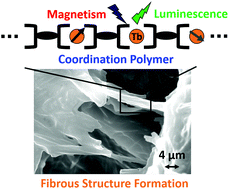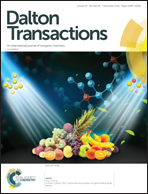Slow magnetic relaxation in a Tb(iii)-based coordination polymer†
Abstract
A Tb(III)-based coordination polymer (polyTb) was synthesized by complexation of Tb(NO3)3·(6H2O) and 4′,4′′′′-[1,1′-biphenyl]-4,4′-diylbis[6,6′′-bis(ethoxycarbonyl)2′:6′,2′′-terpyridine](L). The polymer structure was determined by Job's plots, DFT calculation, and X-ray absorption fine structure (XAFS) measurement. Job's plots indicated that the mole ratio (Tb ion : L) is 1 : 1. The optimized model structures suggested a La model: the LaN6⋯(O![[double bond, length as m-dash]](https://www.rsc.org/images/entities/char_e001.gif) C)2 model. The bond distances of La–O and La–N are ∼2.80 Å and 2.60 Å, respectively. The EXAFS fitting indicated that the bond distances of Tb–O and Tb–N are 2.65 Å and 2.95 Å, respectively. polyTb shows field-induced magnetic relaxation in the solid and solution state. The luminescence of polyTb, originating from an f–f transition, was observed (ϕ = 6.9%). polyTb formed a porous structure on a Si substrate, whereas a fibrous complex structure was formed on glass. polyTb chains are orientated on glass, which were determined by XRD.
C)2 model. The bond distances of La–O and La–N are ∼2.80 Å and 2.60 Å, respectively. The EXAFS fitting indicated that the bond distances of Tb–O and Tb–N are 2.65 Å and 2.95 Å, respectively. polyTb shows field-induced magnetic relaxation in the solid and solution state. The luminescence of polyTb, originating from an f–f transition, was observed (ϕ = 6.9%). polyTb formed a porous structure on a Si substrate, whereas a fibrous complex structure was formed on glass. polyTb chains are orientated on glass, which were determined by XRD.



 Please wait while we load your content...
Please wait while we load your content...